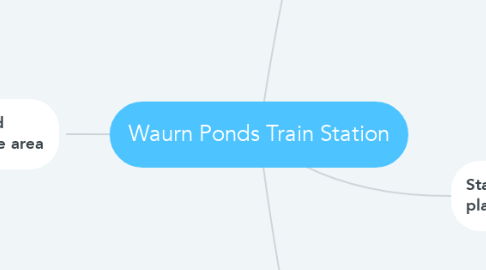
1. Emerging technologies
1.1. user friendly
1.1.1. Uber
1.1.2. train governemnt creating there own ride share services
1.1.2.1. create less peak hour traffic
1.1.2.2. save car parks
1.1.3. linking services with cost like uber and train ticket only paying one fee
1.1.3.1. making the user more aware of costs
1.1.3.2. saving the user time/requiring less cards
1.2. Environment
1.2.1. Replacing the old timber sleepers with the plastic sleepers
1.2.1.1. save around 45 tonnes of plastic per kilometre going into land fill
1.2.2. Using plastic and glass in the concrete footpaths
2. State Government of Victoria planned requirements:
2.1. Parking
2.1.1. Additional spaces
2.1.2. Additional bike stowage
2.1.3. Drop off zone
2.2. Second platform
2.3. Second rail line connecting Waurn Ponds Station to Geelong Station
2.4. Safety
2.4.1. Emergency stops
2.4.2. Lighting
2.4.3. Sealed parking spaces
2.4.4. Crossings and designated foot paths
2.5. Accessibility
2.5.1. Disabled parking spaces close to the station
2.5.2. Overpass with lifts
2.5.3. Ramps
2.5.4. Covered seating
2.5.5. Ground-level crossing
2.5.6. myki tap on/off locations
2.6. Policy
2.6.1. Technical and environmental reports
2.6.2. Community involvement
2.6.2.1. Rail Revival Program
2.6.2.1.1. Community sessions
2.6.2.1.2. Surveys
2.6.2.2. Council
2.6.2.2.1. Meetings where submissions by the public are discussed
3. Train frequency and passenger numbers:
3.1. Growth Area
3.1.1. High growth for residential housing
3.1.2. Planned introduction of industrial area near station
3.2. Current capacity limitations
3.2.1. Train capacity is already high
3.2.2. Peak hour limitations due to single track
4. Social, environmental and financial constraints of the area
4.1. Social
4.1.1. Safety
4.1.1.1. Emergency support
4.1.1.2. Modern technology
4.1.1.3. CCTV
4.1.1.4. Rail attendants
4.1.1.5. Non-slip surfaces
4.1.1.6. Signage
4.1.1.7. Public policy/compliance
4.1.1.7.1. Specialist reports; technical and environmental
4.1.1.7.2. Community involvement
4.1.1.8. Lighting
4.1.2. Accessibility
4.1.2.1. Frequency of trains
4.1.2.2. Linking public and ride-share frequency
4.1.2.3. Location
4.1.2.4. No. platforms
4.1.2.5. No. Parking spaces
4.1.2.5.1. No. Disabled parking spaces
4.1.2.5.2. Bike stowage
4.1.2.5.3. Drop-off zone
4.1.2.6. Crossings
4.1.2.6.1. Safe overpass
4.1.2.6.2. Safe ground-level crossing
4.1.2.7. Roads
4.1.2.7.1. Traffic control
4.1.2.7.2. Roundabouts
4.1.2.8. Amenities services
4.1.2.8.1. Support/information
4.1.2.8.2. Toilets
4.1.2.8.3. Covered seating and walkways
4.1.2.9. myki locations
4.1.2.10. Affordability
4.1.2.10.1. Free parking
4.1.2.10.2. Ticketing
4.1.2.10.3. Ride-share apps
4.2. Financial
4.2.1. Initial cost
4.2.1.1. Local procurement
4.2.1.1.1. Materials
4.2.1.1.2. Labour
4.2.2. Return on investment
4.2.2.1. Benefit-cost ratio
4.2.2.2. Net present value
4.2.2.3. Funding
4.2.2.4. Present return
4.2.2.5. Projected return
4.2.2.6. Indirect benefits
4.2.3. Economic Stimulation
4.2.3.1. Local economic impact
4.2.3.2. Indirect benefits
4.2.3.2.1. Financial gain - back to the Government
4.2.3.3. Direct benefits
4.2.3.3.1. Better services for the community
4.2.3.3.2. Increased employment
4.3. Environmental
4.3.1. Transport Energy
4.3.1.1. Emissions
4.3.1.1.1. Reduced
4.3.1.2. Clean energy return
4.3.1.3. Renewable energy
4.3.1.3.1. Future technologies enabling the train to be electric with electricity being sourced from renewable resources
4.3.1.4. Energy consumption
4.3.1.5. Transport for construction
4.3.1.5.1. Reduced through local procurement
4.3.2. Consumption
4.3.2.1. Recycling
4.3.2.1.1. Glass and plastic bottles for footpaths
4.3.2.1.2. Glass and plastic bottles for car park sealing in the future?
4.3.2.1.3. Plastic for rail sleepers
4.3.2.2. Disposal
4.3.2.3. Waste
4.3.2.3.1. Reduced through effective project management and waste plans
4.3.2.4. New materials
4.3.2.4.1. Local procurement
4.3.3. Land
4.3.3.1. Environmental specialist reports
4.3.3.1.1. Fires
4.3.3.1.2. Flooding
4.3.3.1.3. Heritage
4.3.3.1.4. Land quality
4.3.3.1.5. Construction impact and pollution
4.3.3.1.6. Operating impact and pollution
4.3.3.2. Availability
4.3.3.2.1. Garden beds in spare spaces
